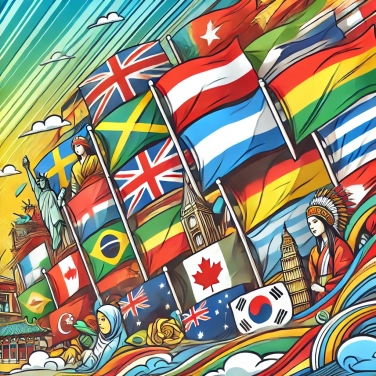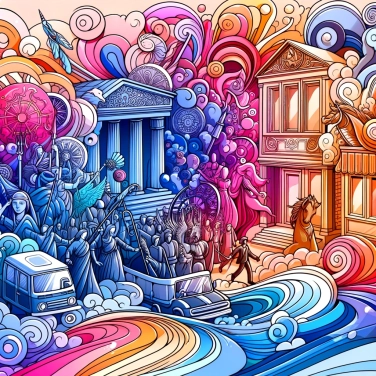The flags of some countries may have similar colors because these colors often have common symbolic or historical meanings, regardless of the deep cultural differences between these countries.

Many countries have similar flags because they often share a common piece of history that goes back a long way. For example, many Arab nations use red, green, black, and white because they are inspired by the colors of the Arab Revolt, a significant period from the early 20th century. The same applies in Africa: the colors green, red, and yellow come from the flag of Ethiopia, the only African country that was never colonized. This trio of colors symbolizes the fight against colonization and African pride; several neighboring countries have adopted them to show their solidarity and common heritage. In Europe as well, blue, white, and red are very widespread, largely due to the influence of Revolutionary France, which inspired freedom movements throughout the continent. In short, if you sometimes feel that flags are copying each other, it is often because they collectively tell a similar part of their history.
Some colors are very widespread because they have a simple and easily understandable meaning around the world. For example, red is often associated with courage, spilled blood, or revolution. White, on the other hand, generally represents peace, purity, or transparency. With green, people often think of hope, agriculture, or Islam, while blue often evokes freedom, oceans, or the sky. As for yellow or gold, they typically symbolize wealth, the sun, or prosperity. Even if countries have very distant cultures, they often use these colors because their message is understandable to everyone.
Some countries have chosen the colors of their flag in response to political events or as a legacy of former colonial dominations. Many African countries, for example, display similar colors (green, yellow, red, or black) as a reference to the colors of Pan-Africanism, a political movement advocating for the unity of Africa in the face of its colonial past. The red, white, and blue are also commonly found in countries once dominated by major European colonial empires such as France or the Netherlands, which partly explains why culturally different nations share nearly identical colors. Similarly, several flags in Latin America use blue, white, and red due to the historical influence of revolutionary and republican ideology linked to independence and the values stemming from the French Revolution. These common colors mainly reflect a shared historical episode or a political tradition bequeathed by other countries, rather than a true cultural link.
The flag of Romania and that of Chad are almost identical with three vertical stripes of blue, yellow, and red. However, these countries have nothing in common in terms of history or culture. Romania uses these colors inspired by its historical past and its struggle for independence in the 19th century against neighboring empires. Chad, on the other hand, chose them during its independence in 1960, symbolizing the sky, the sun, and courage. Same colors, totally different meanings.
Another classic example is the flags of the Netherlands and Russia, which consist of horizontal stripes of red, white, and blue, and look very similar. However, the Netherlands adopted these colors as early as the 16th century to represent their maritime and commercial identity, while Russia, influenced by these Dutch colors, adopted them in the 17th century under Peter the Great to modernize the country's image towards the West. Two distant countries, two very distinct histories, but the same color palette.
The flag of Nepal is unique: it is the only national flag that does not have a rectangular shape, but rather an original combination of two overlapping triangles!
The Olympic flag, featuring five interlocking rings of different colors, was designed in 1913. Symbolizing the unity of the five continents, at least one of the colors present (blue, black, yellow, green, and red, along with the white background) can be found on the flag of each participating country.
Did you know that the colors red, white, and blue are the most common colors on national flags around the world? They appear together in over 20% of national flags!
Several countries from different continents, such as Colombia, Ecuador, and Venezuela, use almost identical flags due to their historical belonging to Gran Colombia in the early 19th century.
The colors of flags can originate from major historical events, the nature and climate of the country, or symbolize cultural or religious values that are important to its citizens.
Some countries have almost identical flags, such as Chad and Romania, which display flags with nearly identical colors, or New Zealand and Australia, which have very similar designs. The resemblance often stems from shared historical or colonial legacies.
There are no strict international rules. However, most countries follow certain conventions: graphic simplicity, a limited number of colors that are clearly distinguishable from a distance, allowing for quick and easy recognition.
National flags play a significant role in patriotic identity and can symbolize the country's history, values, culture, as well as its political or economic aspirations.
These colors are often associated with universal values such as freedom, peace, and courage. Furthermore, historically, these colors come from influential European flags that have marked different regions of the world.

No one has answered this quiz yet, be the first!' :-)
Question 1/5